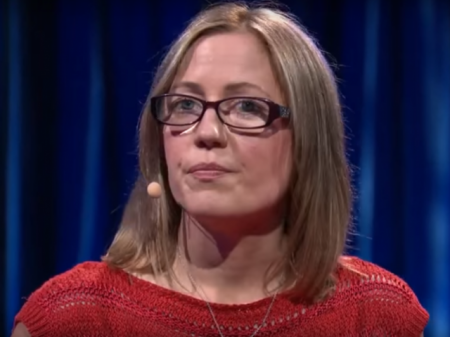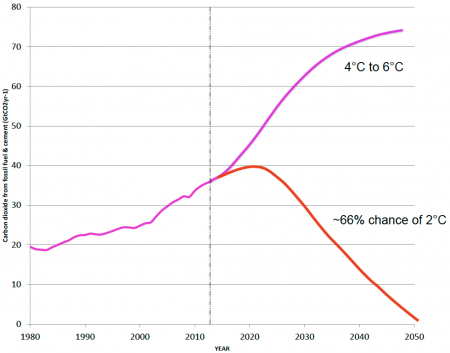March 8, 2016 – Today’s headline calls for global action, and in particular, an immediate response from the Developed World to start cutting greenhouse gas emissions now. This is not alarmist thinking. It is a reality check based on scientific evidence.
In the last week we watched Canadian leaders gather from provinces, First Nations and the federal government, with a goal to establish a carbon reduction strategy starting with a carbon tax. There was little progress as some premiers facing elections put their interests ahead of the common good. In the end the agreement was to hold further talks in the fall with the idea of carbon pricing as something to do in the future. Not nearly good enough in light of what climate science, climate models and emissions tracking are indicating.
In similar fashion the U.S. Supreme Court decided to put a hold on the U.S. Government’s attempt to implement an Environmental Protection Agency initiative nationwide focused on reducing greenhouse gases and accelerating the closure of coal-fired power plants. The reason for blocking the EPA in a 5-4 vote was one of states’ rights with the belief that the agency was exceeding federal government authority under the American Constitution.
All of this hooey is a symptom of a much larger global malaise in addressing climate change. The European Union in the last week acknowledged that it cannot possibly under current policies achieve its carbon reduction targets by 2030.
It’s as if the goodwill and hope of COP21 have evaporated. And that is dangerous. Why?
The Reality Check of Climate Change
In a TED Talk by Alice Bows-Larkin, Professor in Climate Science and Energy Policy, University of Manchester, given in June of last year, she stated that current slow-to-act carbon reduction policies will lead to a global average rise in temperature of 4 Celsius (over 7 Fahrenheit) at the low end by the end of the century. And because temperature rises differ over continental land masses than oceans, that 4 Celsius rise will translate to urban temperature spikes as high as 10 to 12 Celsius (18 to almost 22 Fahrenheit) in years to come. Temperatures this extreme will make urban living conditions hell. That’s straight talk from a climate scientist who feels she has nothing to lose in telling it like it is. She is basing her insights on scientific evidence, not political expedience.
Bows-Larkin argues that economic progress in the Developing World to raise people out of poverty will put further pressure on Developed World countries because more greenhouse gases will get emitted for those countries to catch up. More greenhouse gas accumulation means higher temperatures.
The implications for global policy should be transparent. If Developing World countries emit more than Developed World countries must emit less. Have you heard any politician in the Developed World stating this? Of course not. After all what government wants to tell its citizens “sorry folks, for the next two decades we offer you austerity with all that implies or else we literally will be toasting and roasting.”
Bows-Larkin in her TED Talk quotes from a paper she co-authored in 2011 in which she states, “to avoid the 2-degree framing of dangerous climate change, economic growth needs to be exchanged at least temporarily for a period of planned austerity in wealthy nations.” She goes on, “This is a really difficult message to take, because what it suggests is that we really need to do things differently. This is not about just incremental change. This is about…..whole system change, and sometimes it’s about doing less things. And this applies to all of us, whatever sphere of influence we have.”
So what is the cumulative emissions issue leading to this dire prediction and what is the solution?
Carbon dioxide, methane and other greenhouse gases going into the atmosphere today remain in our atmosphere, some for decades, some for a century or more. Every day we burn more fossil fuel whether it be gasoline and diesel used by trucks and cars, bunker fuels in ships, aviation fuel in jets, coal in thermal power plants, and natural gas in homes, the emissions continue to accumulate. And even if we burn less of them now than in previous years we continue to add more cumulatively. That means the greenhouse gases aren’t going away in the immediate future and may linger for centuries.
Radical emission reductions represent the only way to avoid the high carbon future of extreme temperatures and weather for which our current infrastructure and society is ill prepared. No dialogue among nations at COP21, Developed or Developing, suggests we are dealing with the reality of the future we face. The science in climate models doesn’t point to the 1.5 or 2 Celsius limit talked about at COP21. Instead we face a 4 Celsius curve based on current policy and the pace of action by governments to address the climate file.
The graph below shows two diverging paths for our world’s climate. Current climate reduction actions by government is represented in the upper curve and the troubling trend it represents. The lower curve, the needed course correction, requires policy and actions to reduce carbon emissions by two-thirds between now and 2032 and to achieve zero net emissions from that year onward. That’s a tall order for governments who appear to be sleep walking about implementing climate change policies with any meat.
Whether it is Supreme Court intervention in the United States or stone walling by provincial premiers in Canada to withhold action on carbon pricing, we are being poorly served by those who hold the collective interest of nations in their hands.
So what actions have to happen?
- A few nations are responsible for between 40 and 60% of global emissions today (the United States, European Union, China, Canada, Australia, India and others). They have to initiate strong enforceable carbon reduction policies now. The time for dithering and delay is over. That means stop the talks and get to work.
- National priorities should focus on lower per capita energy consumption by introducing policies to eliminate all low efficiency products from economies including gasoline guzzling vehicles, high-energy sucking residential appliances, energy inefficient industrial machines, coal-fired power plants, carbon-intensive industrial processes, etc.
- GDP growth must no longer be the bell weather statistic by which government’s measure economic success. This constant need for growth is leading us down a hellish rat hole. We need alternative measures to index national and global success.
- Renewable energy infrastructure needs dramatic acceleration, a Marshall Plan sized program with global reach.
Roberto Mangabeira Unger, Brazilian philosopher, politician and Harvard Law School professor, once stated, “At every level the greatest obstacle to transforming the world is that we lack the clarity and imagination to conceive that it could be different.”
Governments take heed. Innovation, imagination and action are needed to meet the climate challenge now. Anything less will mean collectively we have failed and the climate consequences for our children in a 4 Celsius warmer world will be dire.
















